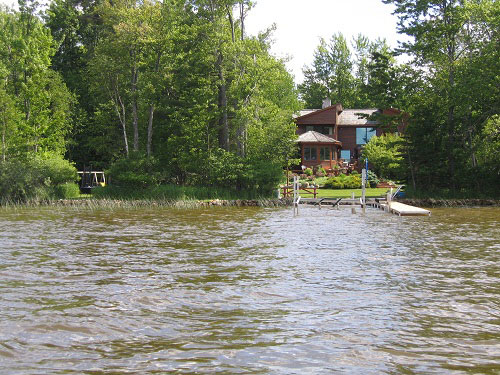Do your part to protect water quality
Become a riparian steward by taking simple steps to manage shoreline property.

Phosphorus is a nutrient that stimulates plant growth. Phosphorus-containing fertilizers, if allowed to enter a body of surface water, have the potential to cause excessive algal growth, decreased water quality and harm to aquatic life. It is important to be aware of the recent amendments to the Michigan Fertilizer Law that went into effect on Jan. 1, 2012. The law includes a number of new water quality best management practices. For example, fertilizer cannot be applied within 15 feet of surface water unless there is a continuous natural vegetative buffer at least 10 feet wide that separates the lawn from surface water or a fertilizer spreader guard/deflector shield or drop spreader is used and fertilizer is not applied less than three feet from surface water. For more information on these new restrictions, visit the Be Phosphorus Smart! or Michigan Department of Agriculture and Rural Development Fertilizer Program website.
Here are a few ideas that will help you to be a responsible riparian steward and be in compliance with the recent updates to the Michigan Fertilizer Law:
Create a no-mow, no-application zone to the area adjacent to the water
This is a vegetative buffer area adjacent to the water where you do not apply pesticides or fertilizers. Consider no longer mowing this area or keeping the height of cut as tall as you can possibly stand it. This combination of practices will encourage native plants to grow, which can do a better job of anchoring soil in place and filtering fertilizers and other contaminants and preventing them from entering water.
Don’t Guess, Soil Test in Order to Fertilize Smartly
Most lawns don’t require phosphorus-containing fertilizer. Don’t use phosphorus unless a soil test shows a need. This saves you money and helps protect the environment. For more information on home lawn and garden soil testing, visit the MSU Soil Test web site or your local MSU Extension office.
Consider natural Shoreline landscaping as an alternative to mowed lawn all the way to the water’s edge
Using native plants, biodegradable products and other natural materials to stabilize the shoreline, prevent runoff, filter contaminants such as fertilizer and pesticides, and provide habitat for fish and wildlife. MSU Extension Bulletin E-3145, “Natural Shoreline Landscapes on Michigan’s Inland Lakes: Guidebook for Property Owners” is a comprehensive resource on this topic available through the MSUE Bookstore.
Keep unnecessary yard waste away from surface water
Yard waste such as leaves, grass clippings and other yard waste contribute unnecessary nutrients to aquatic ecosystems. When in doubt, keep it out.
Minimize impervious surfaces on your property
This includes paved areas, buildings and heavily compacted areas. Create meandering walkways made of porous materials to minimize hard surfaces that encourage water infiltration and discourage stormwater runoff from draining directly to surface water. If you do have impervious surfaces, be careful to sweep any excess fertilizer and grass clippings back onto the lawn.
MSU Extension Bulletin WQ-52, “Managing Shoreline Property to Protect Water Quality” is a self-assessment tool riparian residents can use to determine which of their activities put them at higher risk for degrading local water resources. You may also wish to share MSU Extension Bulletin E3135, “What Can You Do to be Phosphorus Smart,” with neighbors, friends, and family. Both are available at the MSUE Bookstore.



 Print
Print Email
Email




